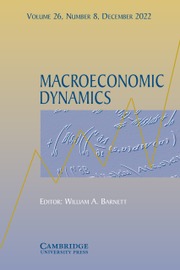No CrossRef data available.
Article contents
Environmental policy and the dynamics of industrial location and residential choice
Published online by Cambridge University Press: 27 October 2025
Abstract
Environmental issues have an international dimension, with causes and consequences that extend beyond national borders—including the effects of the policies designed to address them. This paper investigates how different levels of environmental regulation influence the long-term spatial distribution of firms and households. The results suggest that only highly asymmetric regulations align with the Pollution Haven Hypothesis, causing firms to cluster in areas with lax environmental standards. In contrast, moderate differences in regulation tend to improve environmental quality across regions and can generate positive spillovers for countries adopting greener policies, such as attracting new residents and stimulating investment. While this lends support to the Porter Hypothesis, it does so through a less conventional mechanism. Rather than fostering innovation, stringent regulations enhances regional attractiveness by expanding the market size.
Keywords
Information
- Type
- Articles
- Information
- Copyright
- © The Author(s), 2025. Published by Cambridge University Press

